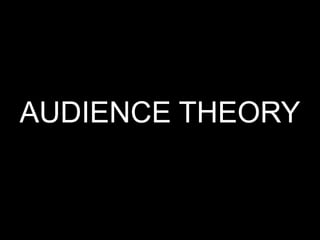
Audience theory
- 2. The Hypodermic Syringe Model • This theory focuses on audience effect. It implies that mass media has a direct, immediate and powerful effect on its audiences. • It suggests that media messages are injected straight into a passive audience who are immediately influenced by the message. This brings forward the view that the media is a dangerous means of communicating an idea because the receiver or audience is powerless to resist the impact of the message – there is no escape. • The model raises the issue of the portrayal of violence and crime in the media, and the effect it has on its audience who supposedly absorb all information given to them. • However, some critics view this model as old-fashioned and have devised more modern models such as the Two Step Flow model. • This model suggests that the media does not directly have an influence on viewers anymore. Instead, interpersonal connections and selective exposure play a larger role in influencing the public in the modern age. • It is also important to consider individual differences such as gender, race, religion, socio- economic background and age – the effects of the media will differ accordingly.
- 3. How can I use this theory? 1) Taking the Hypodermic Syringe model into account, I can conclude that audiences are easily influenced, both positively and negatively, and therefore I should carefully select appropriate ideas and concepts to feature in the video. For example there should not be any extreme violence or drug/alcohol abuse. 2) I must keep the Two Step Flow model in mind when planning the video – it must not be offensive or inappropriate in any way to people of different cultures, ages, races or religions.
- 4. Uses and Gratifications Theory • This theory assumes that members of the audience are not passive but take an active role in interpreting and integrating media into their own lives, in order to fulfil specific gratifications. • This theory would then imply that the media compete against other information sources for viewers' gratification. • Researchers Blulmer and Katz (1974) stated that individuals might choose and use a text for the following purposes: a) Diversion - escape from everyday problems and routine b) Personal Relationships - using the media for emotional and other interaction c) Personal Identity - finding yourself reflected in texts, learning behaviour and values from texts d) Surveillance - Information which could be useful for living
- 5. How can I use this theory? 1) Cognitive needs – many people use song lyrics to keep up to date with political and economic issues and are informed about other cultures. Viewers use the information derived from them to reflect on social issues and their personal relationships (e.g. love songs). 2) Diversion - viewers use music to relax, to escape from boredom and to relieve stress/tension. 3) Social modelling - most viewers choose to belong to a musical sub-culture e.g. . rap, pop, punk or heavy metal. Audiences often use music videos to gain inspiration in terms of clothing, hairstyles and the general image of the subculture.
- 6. Reception Theory • This theory extends the concept of an active audience. • This work was based on Stuart Hall's encoding/decoding model of the relationship between text and audience - the text is encoded by the producer, and decoded by the reader, and there may be major differences between two different readings of the same code. • It also takes into account cultural differences – a basic acceptance of the meaning of a specific text tends to occur when a group of readers have a shared cultural background and interpret the text in similar ways. However, if two readers have vastly different cultural and personal experiences, their reading of a text will vary greatly. • Three main types of reading: a) Dominant reading – accepts preferred reading b) Negotiated reading – modified to reflect reader’s position and interests c) Resistant reading – rejection of preferred reading, bringing forward an alternative frame of interpretation
- 7. How can I use this theory? 1) By using recognised codes and conventions, and by drawing upon audience expectations relating to aspects such as genre and use of stars, I can create a preferred reading, by positioning the audience and thus creating a certain amount of agreement on what the code means. 2) I must take cultural differences into account – although it would be impossible to cater to all cultures’ needs, I will have to think carefully about ways of presenting my message clearly and concisely.